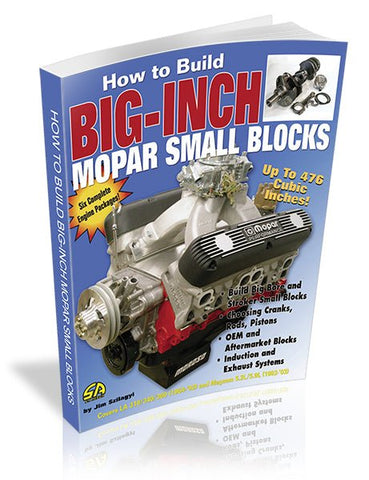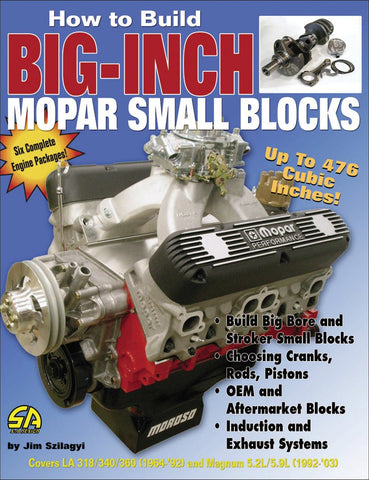At one time, if you wanted big horsepower in your Mopar muscle car or truck, your choices were limited to a big-block swap or a coveted Hemi. At the very least, you needed different engine mounts, K-members, transmissions, headers, etc. -- and Hemis have never been cheap!
But now there's another way to get more horsepower: boring and stroking your Mopar small-block to get more cubic inches -- up to 476 cubes! The small-block Mopar is one of the easiest engines in which to increase displacement without extensive modifications or specialized machine work; the engine was practically designed for more cubes! This book shows you how to get that big-cube power, and then it shows you how to optimize the small-block's other systems -- induction, heads, valvetrain, ignition, exhaust, and more -- to make the most of the extra cubic inches.
Author Jim Szilagyi is a Performance Specialist for Dodge Motorsports and Mopar Performance Parts. In this book he covers building big-inchers from Mopar 318/340/360 -ci LA or Magnum 5.2-/5.9-liter engines, using both factory and aftermarket parts. If you want to make big power from your Mopar small-block, this is the book for you.
Dedication
Acknowledgments
Chapter 1: Introduction
Hot Rod and Street Rod Engines
Production Small-Block Engines
Why LA and Magnum Engines are Shown in the Same Book
Mopar Performance Parts
Chapter 2: Made to be Stroked
Advantages
Potential Problem Areas
Stroker Kits
Chapter 3: Cylinder Blocks
LA Engine Blocks (1964-’92)
360 Magnum Engine Block (1993-’03)
340 Replacement Engine Block
R3 Engine Block
Aluminum A Engine Block
Block Preparation
Block Selection
Chapter 4: Crankshaft
Crankshaft Basics
Types of Cranks
Stroke
Bearings
Internal and External Balance
Chapter 5: Oiling System
Problems with the Stock Oiling System
Recommended Modifications
Optional Modifications
Conclusion
Chapter 6: Connecting Rods
Rod Length
Rod Ratio
Stock LA Rods
Stock Magnum Rods
Fasteners
Block Clearance
Pre-Assembly
Conclusion
Chapter 7: Pistons and Rings
Material and Processes
Forged
Dished, Flat Top, or Dome?
Valve Clearance
Compression Height
Weight
Rings
Conclusion
Chapter 8: Camshafts
Production Cams
Cam Bearings
Cam Drive
Timing Chain Tensioner
HP Thrust Plate
Fuel Pump Eccentric
Problems with Flat Tappet Camshafts
Stroker Cams
Roller Tappets on R3 Blocks
Aluminum Blocks
Used R3 Blocks
Conclusion
Chapter 9: Cylinder Heads
Iron vs. Aluminum
Valve Angle
Valve Spacing
Ports & Chambers
Flow
Cylinder Head Selection
CNC Porting
Conclusion
Chapter 10: Valvetrains
48-Degree Valvetrain
Valvetrain Oiling
Tappets
Pushrods
Rocker Arms – LA Heads
Rocker Arms – Magnum Heads
Valvesprings
Retainers
Valves
Valve to Guide Clearance
Conclusion
Chapter 11: Induction Systems
Manifold Types
LA 340/360 Heads
W2 Heads
W8, W9 Heads
Indy 360-2 Heads
Magnum Heads
Fuel Pump
Magnum Fuel Injection (MPI) Intakes
Magnum Intake – Oil Leaks
Distributor Clearance
Cross-Over Pocket
Conclusion
Chapter 12: Exhaust Systems
Header Basics
Types of Headers
LA Heads
Magnum Heads
W2 Heads
W9 Heads
Exhaust System
Chapter 13: Cooling Systems
Cooling Theory
Improved Cooling
Cross Drilling Block
Cylinder Head Modification
Radiator
Electric Cooling Fan
Oil Cooler
Water Pump
Radiator Cap
Airflow Through the Radiator
Overflow Bottle
Coolants
Conclusion
Chapter 14: Building and Blueprinting
Block Preparation / Engine Mockup
Disassembly and Cleaning
Final Assembly
Additional Information
Chapter 15: Engine Packages
Appendix A:
Stroker Kits
Appendix B:
Source Guide
Source by Type of Product
Engine Build Sheet
At one time, if you wanted big horsepower in your Mopar muscle car or truck, your choices were limited to a big-block swap or a coveted Hemi. At the very least, you needed different engine mounts, K-members, transmissions, headers, etc. -- and Hemis have never been cheap!
But now there's another way to get more horsepower: boring and stroking your Mopar small-block to get more cubic inches -- up to 476 cubes! The small-block Mopar is one of the easiest engines in which to increase displacement without extensive modifications or specialized machine work; the engine was practically designed for more cubes! This book shows you how to get that big-cube power, and then it shows you how to optimize the small-block's other systems -- induction, heads, valvetrain, ignition, exhaust, and more -- to make the most of the extra cubic inches.
Author Jim Szilagyi is a Performance Specialist for Dodge Motorsports and Mopar Performance Parts. In this book he covers building big-inchers from Mopar 318/340/360 -ci LA or Magnum 5.2-/5.9-liter engines, using both factory and aftermarket parts. If you want to make big power from your Mopar small-block, this is the book for you.
Dedication
Acknowledgments
Chapter 1: Introduction
Hot Rod and Street Rod Engines
Production Small-Block Engines
Why LA and Magnum Engines are Shown in the Same Book
Mopar Performance Parts
Chapter 2: Made to be Stroked
Advantages
Potential Problem Areas
Stroker Kits
Chapter 3: Cylinder Blocks
LA Engine Blocks (1964-’92)
360 Magnum Engine Block (1993-’03)
340 Replacement Engine Block
R3 Engine Block
Aluminum A Engine Block
Block Preparation
Block Selection
Chapter 4: Crankshaft
Crankshaft Basics
Types of Cranks
Stroke
Bearings
Internal and External Balance
Chapter 5: Oiling System
Problems with the Stock Oiling System
Recommended Modifications
Optional Modifications
Conclusion
Chapter 6: Connecting Rods
Rod Length
Rod Ratio
Stock LA Rods
Stock Magnum Rods
Fasteners
Block Clearance
Pre-Assembly
Conclusion
Chapter 7: Pistons and Rings
Material and Processes
Forged
Dished, Flat Top, or Dome?
Valve Clearance
Compression Height
Weight
Rings
Conclusion
Chapter 8: Camshafts
Production Cams
Cam Bearings
Cam Drive
Timing Chain Tensioner
HP Thrust Plate
Fuel Pump Eccentric
Problems with Flat Tappet Camshafts
Stroker Cams
Roller Tappets on R3 Blocks
Aluminum Blocks
Used R3 Blocks
Conclusion
Chapter 9: Cylinder Heads
Iron vs. Aluminum
Valve Angle
Valve Spacing
Ports & Chambers
Flow
Cylinder Head Selection
CNC Porting
Conclusion
Chapter 10: Valvetrains
48-Degree Valvetrain
Valvetrain Oiling
Tappets
Pushrods
Rocker Arms – LA Heads
Rocker Arms – Magnum Heads
Valvesprings
Retainers
Valves
Valve to Guide Clearance
Conclusion
Chapter 11: Induction Systems
Manifold Types
LA 340/360 Heads
W2 Heads
W8, W9 Heads
Indy 360-2 Heads
Magnum Heads
Fuel Pump
Magnum Fuel Injection (MPI) Intakes
Magnum Intake – Oil Leaks
Distributor Clearance
Cross-Over Pocket
Conclusion
Chapter 12: Exhaust Systems
Header Basics
Types of Headers
LA Heads
Magnum Heads
W2 Heads
W9 Heads
Exhaust System
Chapter 13: Cooling Systems
Cooling Theory
Improved Cooling
Cross Drilling Block
Cylinder Head Modification
Radiator
Electric Cooling Fan
Oil Cooler
Water Pump
Radiator Cap
Airflow Through the Radiator
Overflow Bottle
Coolants
Conclusion
Chapter 14: Building and Blueprinting
Block Preparation / Engine Mockup
Disassembly and Cleaning
Final Assembly
Additional Information
Chapter 15: Engine Packages
Appendix A:
Stroker Kits
Appendix B:
Source Guide
Source by Type of Product
Engine Build Sheet










